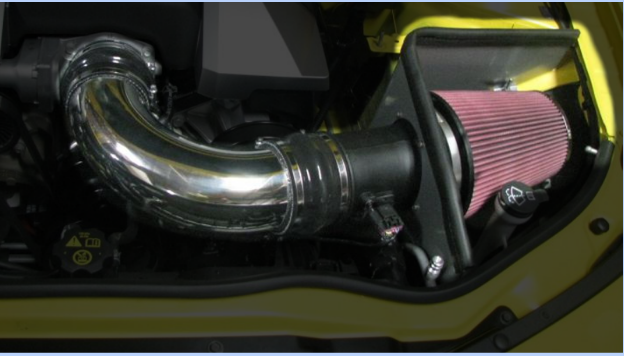[ad_1]
Unlocking the full potential of your vehicle’s engine is a path that many automotive enthusiasts pursue. Among the many options of performance upgrades available, a cold air intake stands out as a popular choice for those seeking to enhance engine efficiency and power output.

A cold air intake (CAI) is an aftermarket modification designed to replace the stock air intake system of a vehicle. Unlike factory air boxes, which often consume space and reduce noise over performance, cold air intakes are engineered to maximize airflow to the engine while reducing the temperature of the incoming air. By relocating the air filter away from the engine bay and incorporating larger diameter tubing, smoother bends and high-flow filters, CAIs aim to provide a denser, cooler air to the engine, thereby improving combustion efficiency and likely increasing horsepower and torque output.
How to Modify your Intake (Full Guide)

1. Increased Power and Torque:
By delivering cooler, denser air to the engine, a cold air intake can enhance combustion efficiency, resulting in an increase in horsepower and torque. This additional power can translate to improved acceleration and overall performance, especially in high-demand driving conditions.
2. Improved Engine Response:
A cold air intake can also enhance throttle response, making your vehicle feel more responsive and active while pressing the accelerator. The smoother flowing piping and optimized intake tract reduce restrictions, allowing the engine to breathe more freely and deliver power more efficiently across the whole RPM range.
3. Enhanced Engine Sound:
For enthusiasts seeking a more aggressive engine sound, a cold air intake can deliver an audible improvement. The unrestricted airflow and induction noise produced by the CAI can create a more satisfying engine sound, enhancing the driving experience further.
4. Potential Fuel Efficiency:
While not guaranteed, some users report gains in fuel efficiency after installing a cold air intake. The improved combustion efficiency and optimized airflow can lead to more efficient fuel consumption under certain driving conditions, although individual results may vary.

1. Risk of Hydrolocking:
Cold air intakes typically position the air filter in lower or more open areas of the vehicle’s front bumper or fender to draw in cooler outside air. However, this placement increases the risk of hydrolocking; the ingestion of water into the engine, especially in heavy rain or flooded road conditions. Hydrolocking can cause catastrophic engine damage and void warranties if caused by a CAI, making it a concern for some drivers in overly wet climates.
2. Potential for Check Engine Lights:
Installing a cold air intake may alter the airflow characteristics of the engine, potentially triggering the vehicle’s onboard computer which might create a check engine light. While this issue can often be resolved with a tune or aftermarket engine management system, it’s an additional con to consider when planning on installing a CAI.
3. Legal Compliance:
In some places, modifying the vehicle’s emissions or intake system may violate local regulations and emissions standards. It’s essential to research and understand the legal implications of installing a cold air intake in your area to avoid fines or penalties.
1. Short Ram Intakes:
Short Ram Air Intakes function similarly to cold air intakes but utilize a different design to capture outside air. Instead of relocating the air filter away from the engine bay, ram air intakes feature a shorter intake tube. This allows for quickly intaking air with the least flow restrictions. Short Ram Intakes have one fatal flaw which is that it often sits in hot air within your engine bay. One way this is combated is by installing a heat shield to help divide the hot air of the engine and the cooler outside air.

2. DIY Cold Air Intakes:
For budget conscious enthusiasts and those with mechanical skills, constructing a Cold Air Intake using off the shelf components is a viable alternative to purchasing a pre-made kit. By carefully selecting tubing, filters, and heat shielding materials, one can create a custom Cold Air Intake tailored to their vehicle’s specifications and performance goals.
See: Free Performance Modifications
Will installing a cold air intake void my vehicle’s warranty?
It depends on the manufacturer and the terms of your warranty agreement. Some manufacturers may consider aftermarket modifications like cold air intakes as a void to certain aspects of the warranty, so it’s essential to research and understand your warranty coverage before proceeding.
Can I install a cold air intake myself?
You can absolutely install a cold air intake with the appropriate tools, skills and instructions. However if you do not feel confident in your skills you can consult with a professional to help install your cold air intake for you.
Will a cold air intake improve fuel efficiency?
Reports from some mention modest enhancements in fuel economy after installing a Cold Air Intake, the outcomes will likely differ depending on variables such as personal driving behaviors, the vehicle, and the environment. The primary benefits of a cold air intake typically include increased power and engine response rather than fuel economy improvements, but it is not totally uncommon.
Consulting with automotive experts beforehand guarantees that any adjustments to your vehicle obey laws to avoid potential penalties or unnecessary repairs. Improper installation or misuse of cold air intakes can affect engine performance, reliability, and emissions compliance.
A cold air intake is a great opportunity for automotive enthusiasts to unlock additional power and performance from their vehicles. Delivering a cooler, denser atmosphere to the engine, an air intake has the potential to enhance the efficiency of combustion, throttle reaction, and the noise produced by the engine. Potential drawbacks such as risk of hydrolocking, check engine lights, and legal/warranty compliance issues must be considered before making the upgrade. Whether you opt for a cold air intake, explore alternative solutions, or build your own, proper research and installation will guarantee things run smoothly and you achieve the outcome you desire.
[ad_2]
Source link











